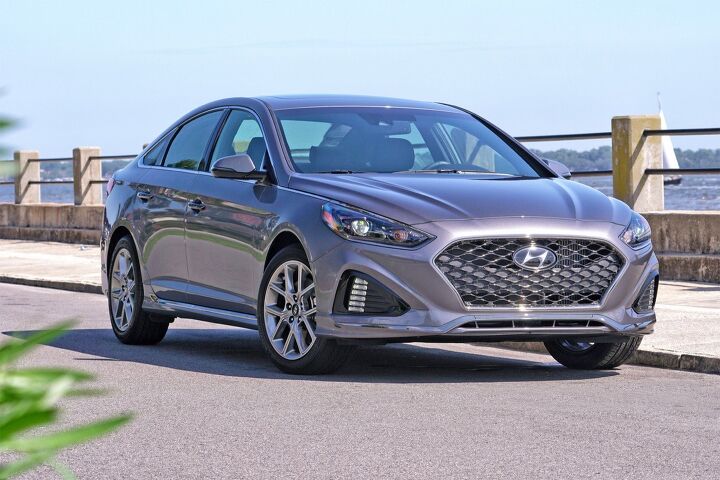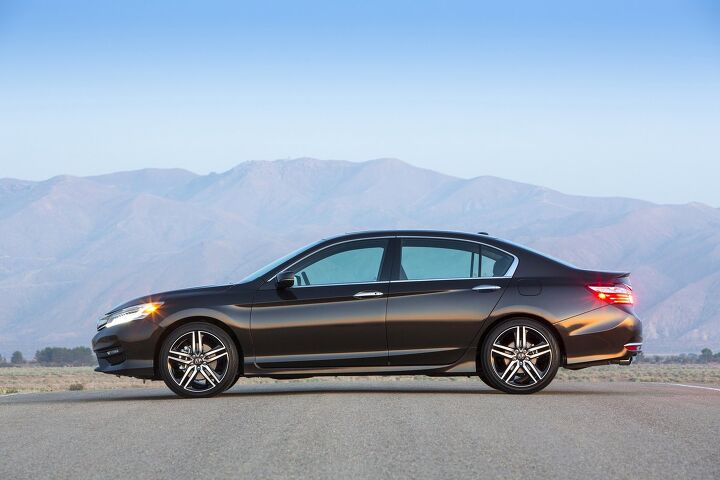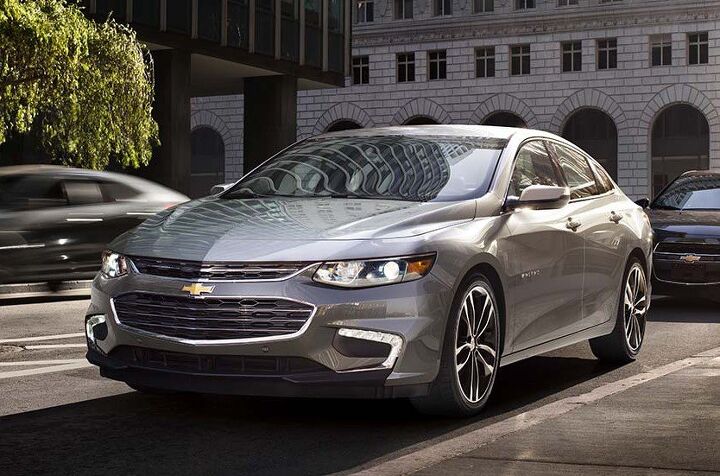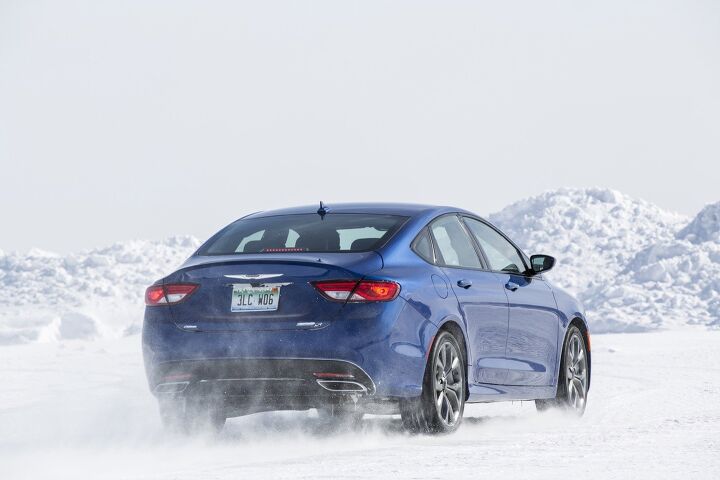#MidsizeCarDeathwatch
Midsize Sedan Deathwatch #17: Trouble In October 2017, Unless Your Name's Honda Accord
U.S. sales of midsize cars plunged 16 percent to fewer than 130,000 units in October 2017, the lowest-volume month for the midsize sedan category since the winter doldrums of January.
For almost every player, from the forgotten Mazda 6 to the recently revamped Hyundai Sonata to the all-new Toyota Camry, there were fewer U.S. buyers in October 2017 than in October 2016. In most cases, far fewer. Hyundai Sonata volume plunged 49 percent, year-over-year, as Hyundai pulls away from daily rentals, clarifying just how little retail demand the Sonata truly musters. Double-digit percentage drops were also reported by the Kia Optima, Subaru Legacy, Volkswagen Passat, and Mazda 6.
But the sharp October tumble wasn’t reserved for each member of the midsize category. Newly launched this fall, U.S. sales of the 10th-generation 2018 Honda Accord predictably improved in October, driving Honda’s share of the segment up four points to 21 percent.
It’s a familiar story.
Midsize Sedan Deathwatch #16: The Decline of the Midsize Class's Middle Class
Ever more minor midsize players continued to see their share of America’s midsize sedan segment dwindle in September 2017. The cause: domination on the part of America’s two major midsize cars.
The all-new 2018 Toyota Camry enjoyed its first full month of meaningful availability in September and produced a 13-percent year-over-year U.S. sales improvement as a result. Meanwhile, Honda is clearing out remaining 2017 Accords in advance of the all-new 2018 Accord’s arrival this fall. Honda’s efforts produced a 10-percent uptick compared with September 2016.
Yet despite the big gains from the two major players, the upper class, the midsize segment still declined 7 percent in September because of sharp declines by many members of the middle class.
That means Camry and Accord market share continues to rise. That means the slice of the market earned by the middle class continues to shrink.
Midsize Sedan Deathwatch #15: Toyota Camry Proves to Be a Killer In August 2017
The launch of the all-new 2018 Toyota Camry began in July 2017 and delivered a big boost to America’s best-selling midsize car in August 2017.
As its competitors combined for a 12-percent loss valued at nearly 16,000 fewer sales than in August 2016, Toyota Camry sales jumped 13 percent, a gain of 4,187 sales. That figure includes 6,805 new-gen Camrys imported from Japan, where the Camry’s home market factory is being relied upon while Toyota’s Georgetown, Kentucky, assembly plant gathers steam for the entirely different Toyota New Global Architecture.
With falling sales across much of the category and rising volume at the top seller, Toyota got exactly what it called for in August 2017: a huge market share increase. But did the Camry provide the rumored boost to the segment overall? Quite clearly no, not yet.
Midsize Sedan Deathwatch #13: 2017's Grim First-half 198,000-unit Loss
Midsize car sales volume decreased by nearly 200,000 units in the United States during the first-half of 2017.
Year-over-year, that 18-percent decline was caused by virtually every member of America’s midsize sedan fleet. Escaping unscathed, on its own, was the Volkswagen Passat, though Passat sales are significantly lower than they were in 2012, 2013, 2014, and 2015.
Aside from the Passat, midsize cars are selling much less often this year than last at every competing automaker; from the top-selling Toyota Camry to the slow-selling Mazda 6, from the all-wheel-drive-optional Ford Fusion to the all-wheel-drive-standard Subaru Legacy; from the new-last-year Chevrolet Malibu to the never-again-new Chrysler 200.
Most automakers, however, are blessed to possess similarly priced compact crossovers that are making up all, much, or some of the slack.
Midsize Sedan Deathwatch #12: Is That An Atlas Intruding Into Your Territory?
The Volkswagen Passat has a roomie.
Production of the Volkswagen Atlas, Volkswagen of America’s first three-row SUV and the automaker’s first three-row vehicle since the Dodge Grand Caravan-derived Volkswagen Routan fled the scene in 2014, began earlier this year in Chattanooga, Tennessee, previously known as the Passat’s factory.
The first 1,610 copies of the Atlas were sold in May 2017.
Volkswagen, which built the Tennessee assembly plant as part of a goal that would see the brand selling 800,000 vehicles in America per year by 2018, originally intended to build 150,000 vehicles annually in Chattanooga. Only half that capacity was used last year.
If the Volkswagen Atlas becomes the hit the Volkswagen Passat never was, what might that say about the North Americanized Volkswagen Passat’s future?
Midsize Sedan Deathwatch #11: Blame Midsize Cars For America's Passenger Car Decline
Why did America’s passenger car market tumble 11 percent in April 2017?
Midsize cars deserve much of the blame.
Why is America’s passenger car market down 12 percent through the first four months of 2017?
Midsize cars deserve most of the blame.
Midsize Sedan Deathwatch #10: In April 2017, Cannibal Camry Feeds as Others Cede
Reaching the end of the line before an all-new 2018 model launches, the outgoing Toyota Camry is — quite predictably — losing sales. After all, the auto industry’s total sales volume is shrinking. Passenger cars, in particular, are paying a price. And the midsize segment is stumbling all the more so. With all these factors contributing, of course the Camry is shedding volume.
Aged, outdated, and antiquated, the Toyota Camry seemingly has the most to lose. Yet despite a 4-percent year-over-year U.S. sales loss in March 2017 and a 13-percent decline through the first-quarter of 2017, the Toyota Camry is gaining heaps of market share in America’s midsize sedan segment, not losing it.
That’s because the cars that are most to blame for the midsize sedan segment’s rapid decline don’t sit at the top of the leaderboard, but rather hail from the JV squad.
Midsize Sedan Deathwatch #9: Detroit's Participants Tumble At Double Speed In February 2017
Aside from the Volkswagen Passat’s 40-percent year-over-year uptick, every automaker competing in America’s midsize sedan segment suffered from declining volume in February 2017.
The midsize car category tumbled 19 percent, a loss of more than 34,000 sales.
February 2017 marked the twelfth consecutive month of year-over-year declines for midsize car sales in America.
This is the ninth edition of TTAC’s Midsize Sedan Deathwatch. The midsize sedan as we know it — “midsizedus sedanicus” in the original latin — isn’t going anywhere any time soon, but the ongoing sales contraction will result in a reduction of mainstream intermediate sedans in the U.S. market.
How do we know? It already has.
The Passat’s exceptional year-over-year uptick by no means represents healthy volume for the big Volkswagen. But the bigger story from February’s results was the horrific nosedive performed by Detroit nameplates: one discontinued nameplate, one of the older members of the midsize fleet, the newest member of the midsize fleet, and one semi-premium niche player.
Midsize Sedan Deathwatch #8: It Got Downright Ugly In January 2017
The Suzuki Kizashi‘s brief tenure came to an end in 2013. 2014 was the last year Mitsubishi produced Galant sales in the United States. 2015 marked the Dodge Avenger’s terminus. The Chrysler 200’s death was announced in 2016.
Will 2017 be a period of further contraction in America’s midsize sedan market?
This is the eighth edition of TTAC’s Midsize Sedan Deathwatch. The midsize sedan as we know it — “midsizedus sedanicus” in the original latin — isn’t going anywhere any time soon, but the ongoing sales contraction will result in a reduction of mainstream intermediate sedans in the U.S. market.
How do we know? It already has.
If January 2017’s results are anything to go by, it’s going to be a very ugly year for midsize cars in the United States; sales tumbled by more than a fifth in January 2017, a year-over-year decline worth 30,000 lost sales.
Midsize Sedan Deathwatch #7: America Lost More Than 250,000 Midsize Car Sales In 2016
As recently as 2014, U.S. sales of midsize cars were on the rise, albeit marginally. As recently as 2015, U.S. sales of midsize cars were shrinking only modestly, falling less than 2 percent compared with 2014.
In 2016, however, U.S. sales of midsize cars decreased by more than 250,000 units — an 11-percent drop that exceeded the rate of decline witnessed elsewhere in the car market.
This is the seventh edition of TTAC’s Midsize Sedan Deathwatch. The midsize sedan as we know it — “midsizedus sedanicus” in the original latin — isn’t going anywhere any time soon, but the ongoing sales contraction will result in a reduction of mainstream intermediate sedans in the U.S. market.
How do we know? It already has.
The midsize sedan segment continues to be a hugely consequential part of the car market and the overall new vehicle market, but the segment has greatly contracted over the last few years — including the demise of yet another nameplate in 2016.
That makes 2017 the best time to replace the 15-time best-seller with an all-new model.

























Recent Comments